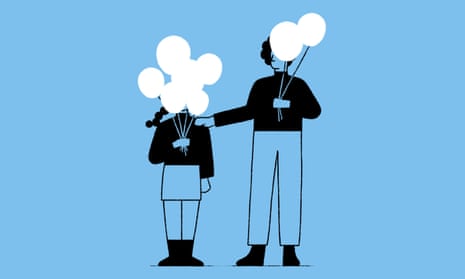
‘Don’t blame the young for being moody’ – and seven other ways to nurture healthy teenage minds
Adolescence is a time of great change, with everything from sleep to social media impacting on growth. Psychologist Sarah-Jayne Blakemore explains how to support positive habits
When I was studying as an undergraduate, almost 30 years ago, I was taught that the human brain stops developing in childhood. But that is wrong. Now that we have the technology to look inside the living human brain and track changes in its structure and function across a lifespan, we know that the brain continues to develop substantially throughout adolescence and into early adulthood.
We define adolescence as the period of life between 10 and 24. This is a relatively new definition, which is partly based on this new knowledge about brain development. The brain changes, both in terms of its function – how it is activated when you do things like make decisions, plan actions, think about other people, or process emotions – and also in its structure. Although the brain is almost adult size by about the age of eight or nine, its internal composition changes radically during adolescence.
Specifically, the amount of grey matter and white matter the brain contains undergoes substantial transition during adolescence. White matter contains long fibres called axons, which allow different regions of the brain to communicate with each other, and white matter increases steadily from very early development until the thirties. This reflects a process called myelination, which speeds up signalling in the brain, making it become more efficient. Meanwhile, from late childhood, in many brain regions, grey matter – which contains cell bodies and connections between neurons, called synapses – undergoes a steady, slow, protracted decline.
Synapses are the connections between brain cells that enable the brain to do its work. The number of synapses increases dramatically during early development, so a young child’s brain contains many more synapses than an adult brain. Those excess synapses then have to be removed. The synapses that are being used within certain environments are the synapses that remain and grow stronger, and those that are not used are eliminated in a process called synaptic pruning. This is a clever way in which the brain develops partly based on the environment it’s growing up in. We are still learning a lot about the adolescent brain, but here are some areas, in which there is compelling scientific evidence, to bear in mind.
The importance of sleep
Sleep is important at all ages, but when the brain is developing it is crucial. Sleep is also key to mental health. Several aspects of sleep change in adolescence. There is evidence that during puberty the sleep-wake cycle, or circadian rhythm changes. Before puberty, melatonin – the sleep hormone – is produced earlier in the evening. After puberty there is a delay by about two hours so we aren’t as sleepy as early. It also means the night cycle has shifted by a couple of hours, which is partly why it is sometimes difficult for teenagers to get up in the morning. They often catch up on sleep at the weekend: this is called “social jetlag” because it resembles changing timezone every week, and that can be pretty hard on the brain, body and mood.
To address this, some scientists and psychologists have argued that the school day should be delayed by an hour or two. This is difficult to enact because it doesn’t fit with social norms and the working patterns of parents, but I do question whether it is optimal for teenagers to be made to get up and go to school in the middle of their biological night.
The influence of screens and social media

Something that does affect sleep is phone use and the urge to check social media late into the night. It has always been the case that socialising is especially important for young people. When I was a teenager, I would be on the landline chatting to my friends for hours, and my parents would tell me to get off the phone and go to bed. Young people can now connect with their friends at all times of day and night, and they often do. There is such social pressure in the teenage years. Missing a notification or a message and not replying could be a social risk that adolescents want to avoid, so some young people stay up later to socialise online and sleep next to their phones.
We don’t know much about the effect of social media on adolescent brains. There have been some studies showing a small relationship between higher social media use and lower wellbeing in teenagers, and that has been taken as evidence that screen time or social media use can cause mental health problems in young people. However, it is just a correlation; it could also be that the other direction is possible – rather than social media causing lower wellbeing, it might be that if you’re feeling low, then your motivation to resort to social media will increase. There is evidence that both directions are possible. There is also some evidence that suggests whether social media is harmful or not is dependent on what is being looked at, and whether people are passively scrolling or actively engaging with others.
Have empathy
Simply knowing more about what is happening in a teenager’s brain can be useful for parents, teachers and other people who work with young people – and for teenagers themselves. It might mean we don’t immediately blame young people for being moody, selfish or making “bad” decisions.
Trying to be more empathic and taking a young person’s perspective is useful, and might help adults understand why young people sometimes act in the way they do. For example, risk-taking is heightened in the teenage years, and most risks – smoking, experimenting with drugs, dangerous driving, for example – are taken when young people are with friends. When we are teenagers, we have a higher propensity to be influenced by peers, and this might be because we are hypersensitive to being socially excluded and motivated to fit in. This is important to the developing young person and it would be a ‘social risk’ to say no to friends. This isn’t because young people don’t care about their family anymore, or because they’re doing things just to annoy the adults in their lives: there’s a strong adaptive pressure on young people to affiliate with peers.
READ RELATED: 10 Best Dumbbell Exercises for Full-Body Strength
We’re still learning about neurodiversity
Our education system and society are set up in a one-size-fits-all way. But we are a neurodiverse species and there are young people in every school and university whose brains process information differently from one another. There has been a lot of research on conditions such as autism, dyslexia and ADHD in young children, but adolescence has been neglected when studying neurodiversity. Yet this is a period with big changes in hormones, the brain and the social world. All of these introduce new pressures on young people, and neurodivergence presents an additional challenge. We need more research on how neurodivergence manifests during the teenage years and how best we can support young people with developmental conditions.
Be alert to signs of mental health problems

Our brains are plastic at all ages, including in adulthood, but during adolescence, neuroplasticity in certain brain regions is heightened. This means that adolescence is a period which offers the opportunity for learning and creativity, and can benefit from interventions.
This heightened neuroplasticity also means it is a time of vulnerability, because the environment isn’t always positive. Stressful circumstances might have an effect on the brain and how it is developing, and might make a young person susceptible to mental health problems: about 75% of mental illness begins before the age of 18.
Keep an eye on stress
The environment that teenagers are growing up in these days is more stressful than it was even 20 years ago. In the UK, the number of exams and assessments has increased for young people. This creates acute stress at a stage when young people are particularly vulnerable.
In addition to academic pressure, young people express worries such as fear of failure, getting on to the job market and the housing ladder, and the climate crisis. Life is especially hard for young people living in poverty. In a recent study led by my colleagues Blanca Piera Pi-Sunyer and Jack Andrews, we found that perceiving yourself as less financially well off than your friends’ families was associated with lower mental wellbeing in early adolescence, over and above your objective family income. These are all quite existential worries to have at an age when there’s not a lot you can do about them – young people don’t have much agency or power, and can’t vote until they’re 18.
The effect of alcohol and drugs

There is some evidence that smoking or consuming relatively large quantities of cannabis regularly before the age of about 18 or 21 is harmful for the brain in terms of cognitive ability, such as memory and learning, and in terms of increased risk of developing psychosis. We know less about the longer-term effects of consuming a lot of alcohol. There is some evidence that it affects the developing brain differently from the adult brain, but we know less about long-term harm to adolescents.
Listen to young people
Young people have a lot of influence over each other, and there is evidence that peer-led interventions, for example anti-bullying campaigns in schools, can be more effective than adult-led campaigns. And yet, very few interventions are designed and led by young people. We need to give adolescents a voice, and empower them to encourage each other to make positive and healthy decisions.
Brain development is substantial throughout the teenage years and into the mid-20s, but it does stabilise and it’s not always going to be like this. I would have found this useful to know when I was a teenager. I hope today’s teens are more informed about the development of their brains.
A colleague, Dr Amy Orben, carried out a study that I was involved with, looking at the relationship between increased social media use and wellbeing in adolescents. What we found was that at most ages, there is almost zero relationship between social media use and wellbeing. There are a few exceptions – at age 11 to 13 in girls, age 14 to 15 in boys, and again at age 19 for both sexes, where higher social media use during one year predicts lower wellbeing the following year. We think that at those earlier ages, which corresponds roughly to when puberty is happening in girls and boys – when hormones, body and brain are all rapidly changing – the way that you’re being treated by society also changes. There is a lot of pressure to act or look a certain way, and be approved by your peers. It is often a socially turbulent period in life, when young people might be inclined to use their phones and might be exposed to the negative effects of social media, such as online social pressure and cyberbullying. Age 19 is when most young people leave home and become independent for the first time, again bringing new social pressures that might lead to potential harm.
Sarah-Jayne Blakemore is a professor of psychology at the University of Cambridge and author of Inventing Ourselves: The Secret Life of the Teenage Brain, published by Black Swan
Source: Health & wellbeing | The Guardian








